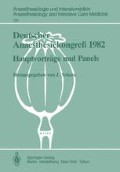Zusammenfassung
Die thyreotoxische Krise stellt eine akute, lebensbedrohliche Verschlechterung einer vorbestehenden Überfunktion der Schilddrüse dar. Die Häufigkeit dieser Erkrankung, bezogen auf die Gesamtzahl beobachteter Hyperthyreosen, wird in der Literatur unterschiedlich mit 0,7–7%, die Letalität der manifesten Krise mit ca. 50% angegeben. Für operative Belange gilt seit langem der Grundsatz, daß operative Eingriffe nur bei euthyreoter Stoffwechsellage vorgenommen werden sollten. Dies findet naturgemäß v. a. bei Schilddrüsenoperationen Beachtung. Der Anteil operierter Hyperthyreosen an der Gesamtzahl der Schilddrüsenoperationen beträgt heute in großen Kliniken etwa 10%, bei einer Operationsletalität von 0,1–0,2%. Anfang der 50er Jahre kam es noch bei 12% der operierten Hyperthyreosen zu einer thyreotoxischen Krise; das Operationsrisiko betrug damals 5–9%.
Access this chapter
Tax calculation will be finalised at checkout
Purchases are for personal use only
Preview
Unable to display preview. Download preview PDF.
Literatur
Althoff PH, Neubauer M, Schöffling K (1980) Klinik und Therapie der hyperthyreoten Krise. Notfall-medizin 6: 110
Ashkar FS, Katims RB, Smoak WM, Gilson AJ (1970) Thyroid storm treatment with blood exchange and plasmapheresis. JAMA 214: 1275
Atzpodien W, Beyer J, Schuster CI (1979) Die Behandlung der thyreotoxischen Krise. Tntensivmed 16: 579
Bay V, Engel U (1980) Komplikationen bei Schilddrüsenoperationen. Chirurg 51: 91
Börner W (1974) Schilddrüsenhormone-Thyreostatika. Med Klin 69: 1407
Bürgi H, Geiser J, Rosier H, Studer H (1978) Die verkannte Hyperthyreose beim Spitalpatienten. Schweiz Med Wochenschr 108: 1257
Dobyns BM (1978) Prevention and management of hyperthyroid storm. World J Surg 2: 293
Dolle W (1973) Nebenwirkungen und Wirkungen der Lithiumtherapie beim Menschen im Bereich des Endokriniums. Internist 14: 175
Gehring D (1973) Die thyreotoxische Krise. Therapiewoche 50: 4899
Herrmann J (1978) Neuere Aspekte in der Therapie der thyreotoxischen Krise. Dtsch Med Wochenschr 103: 166
Kolb E (1975) Vegetative Blockade bei der operativen Behandlung der Basedowstruma. Langenbecks Arch Chir 285: 18
James ML (1970) Endocrine disease and anaesthesia. Anesthesia 25: 232
Josef K (1981) Potentielle Hyperthyreosen. Dtsch Aerztebl 78: 2279
Larsen PR (1982) Thyroid-pituitary interaction. N Engl J Med 306: 23
Laubinger G (1980) Rationelle Schilddrüsendiagnostik. Intensivmed Prax 2: 115
Pickart CR, Werder K (1976) Diagnostik und Therapie endokriner Krisen. Intensivbehandlung 1: 91
Rubenfeld S, Silvermann VE, Welch K, Mellette L, Kohler PO (1979) Variable plasma propanol levels in thyrotoxicosis. N Engl J Med 300: 253
Saeed-Uz-Zafar M, Miller M, Brenemann G, Mansour J (1971) Observations on the effect of heparin on free and total thyroxin. J Clin Endocrinol 32: 633
Spatz R, Nagel J, Kollmannsberger A, Kügler J (1975) Das Elektroencephalogramm bei der Hyper-thyreose und im thyreotoxischen Koma. Z EEG 6: 14
Sterlin K (1979) Thyroid hormone action at the cell level. N Engl J Med 300: 117, 173
Editor information
Editors and Affiliations
Rights and permissions
Copyright information
© 1984 Springer-Verlag Berlin Heidelberg
About this paper
Cite this paper
Rust, M., Zilker, T., Bottermann, P. (1984). Zur postoperativen thyreotoxischen Krise. In: Schara, J. (eds) Deutscher Anaesthesiekongreß 1982 Freie Vorträge. Anaesthesiologie und Intensivmedizin Anaesthesiology and Intensive Care Medicine, vol 161. Springer, Berlin, Heidelberg. https://doi.org/10.1007/978-3-642-69430-1_16
Download citation
DOI: https://doi.org/10.1007/978-3-642-69430-1_16
Publisher Name: Springer, Berlin, Heidelberg
Print ISBN: 978-3-540-12977-6
Online ISBN: 978-3-642-69430-1
eBook Packages: Springer Book Archive

